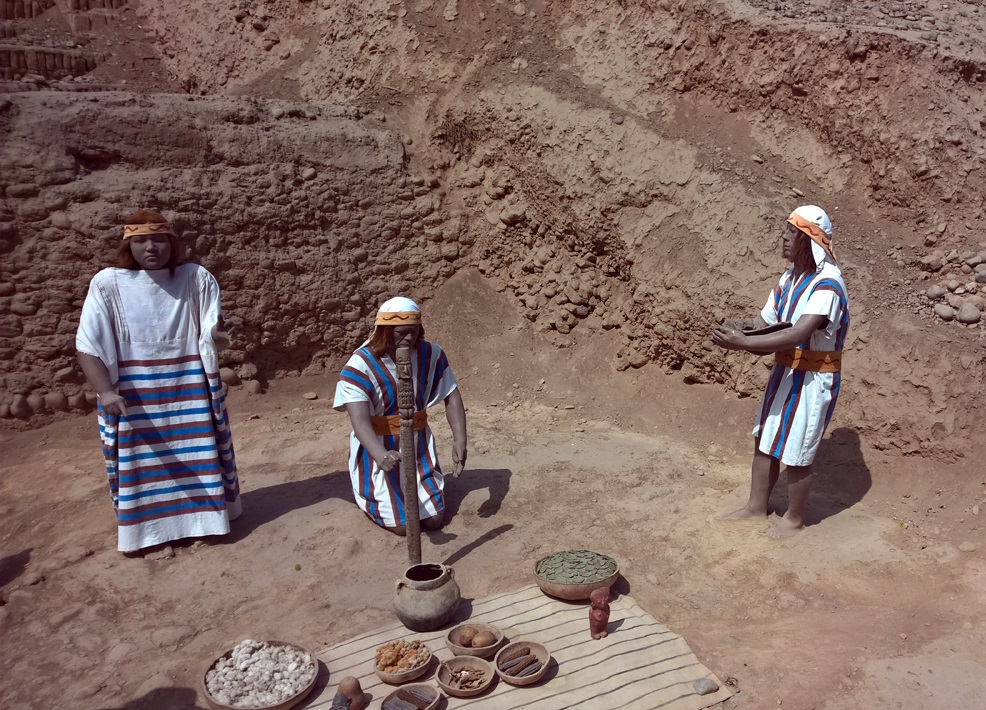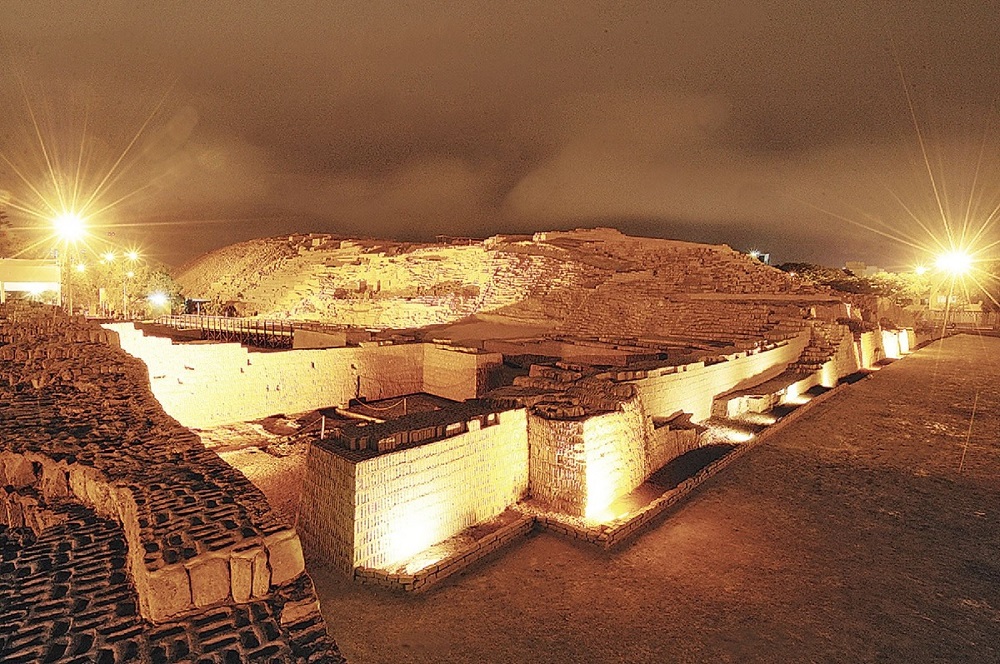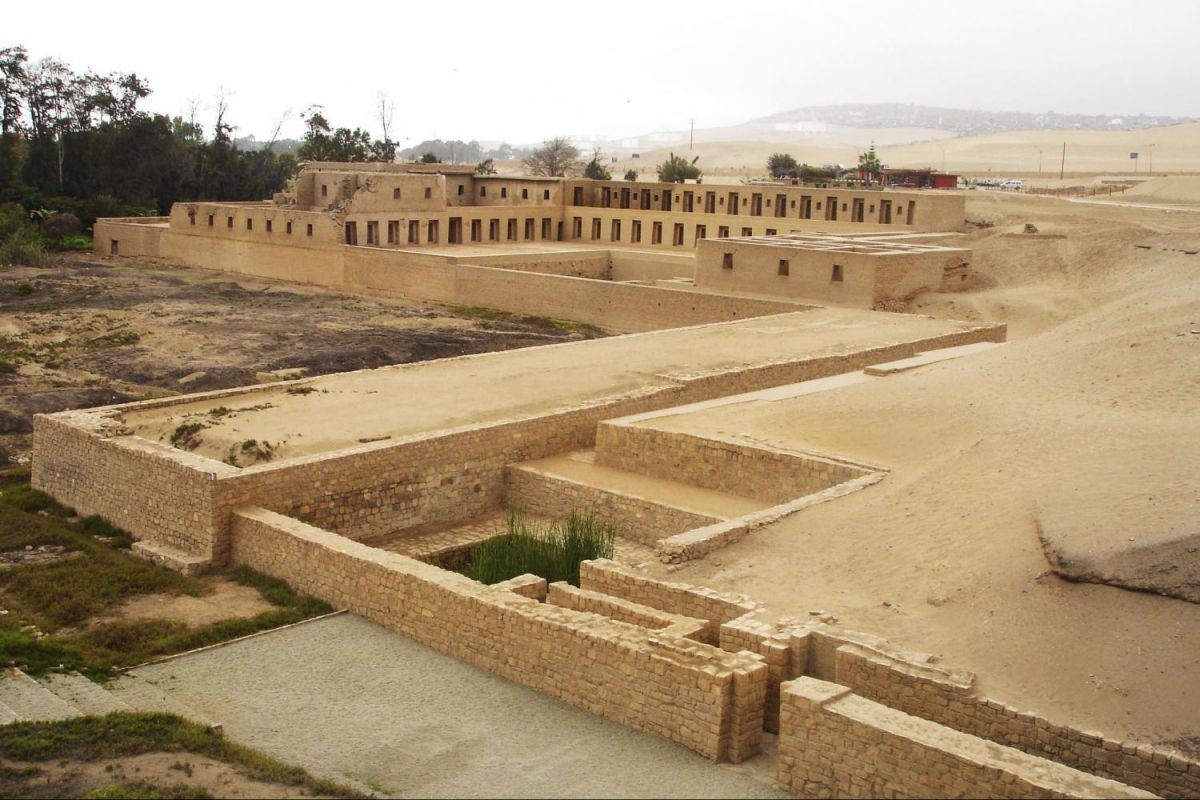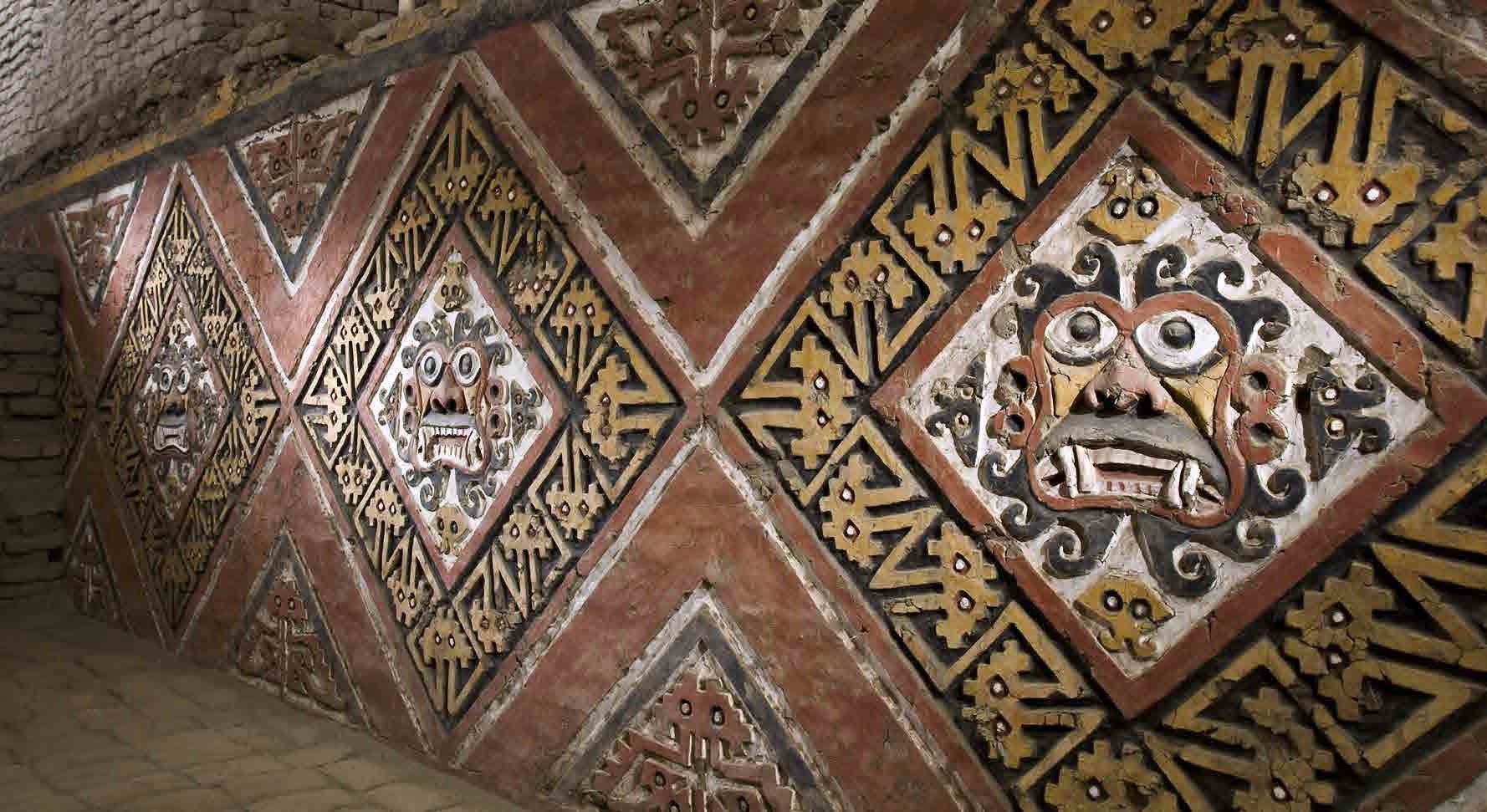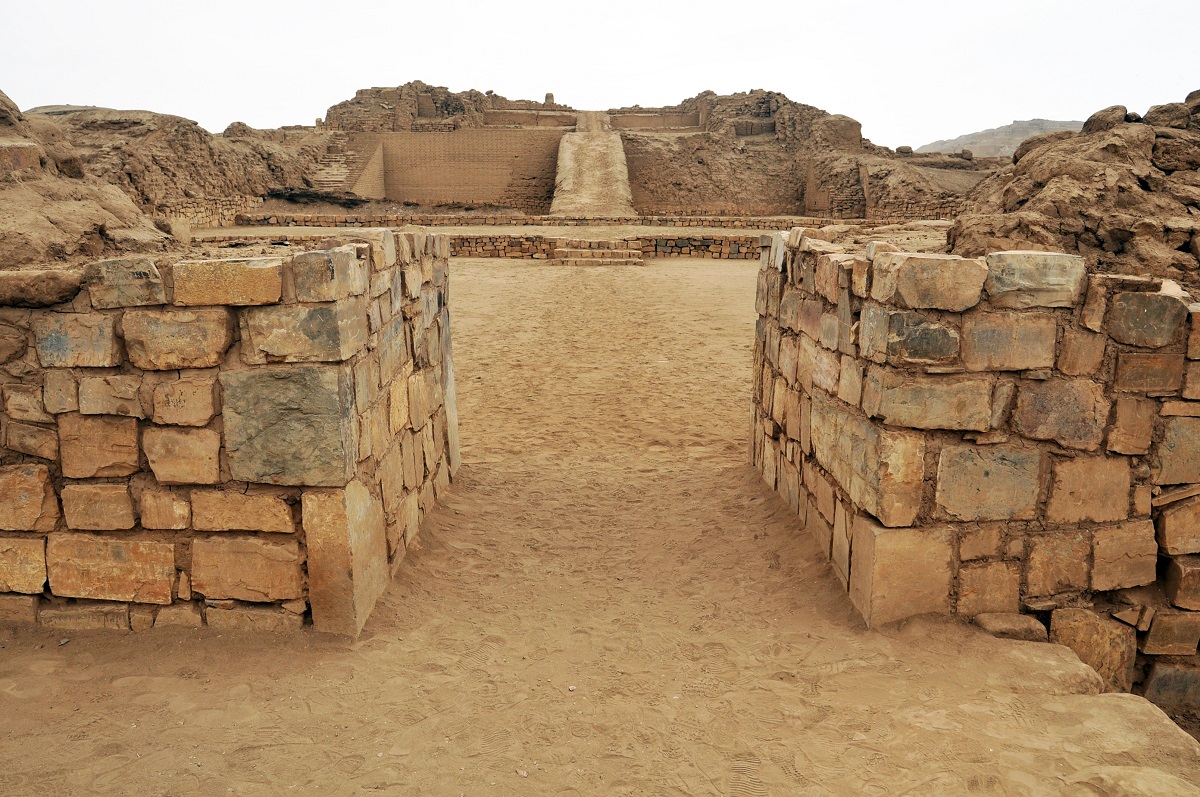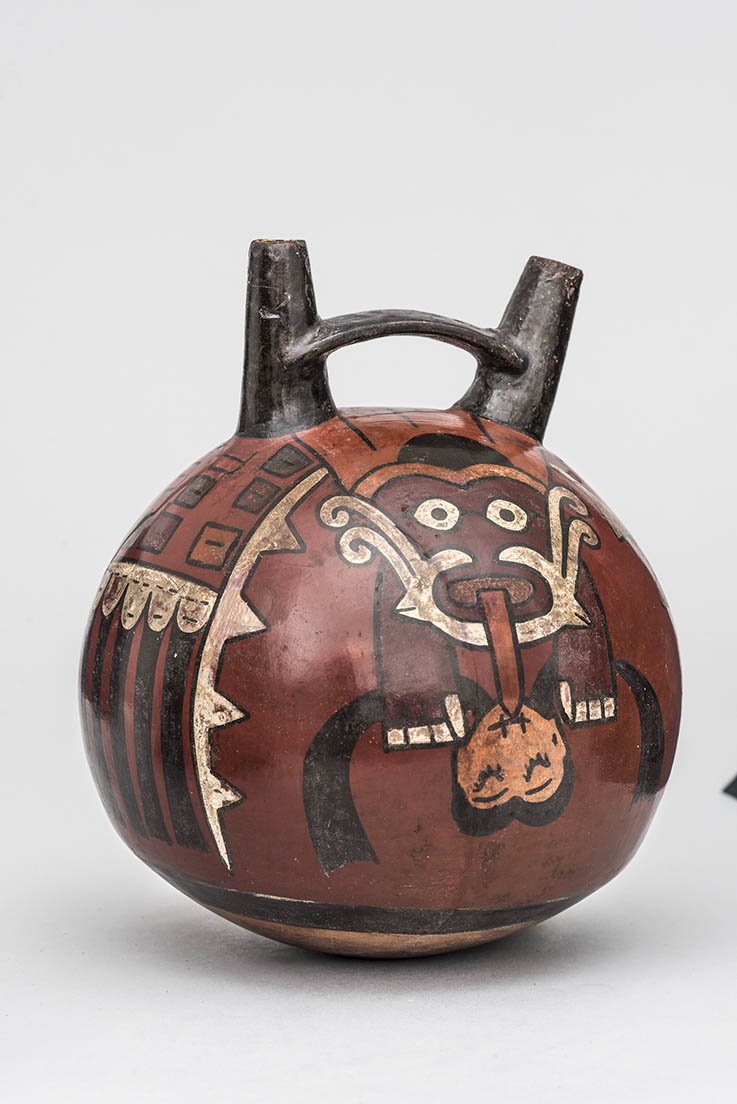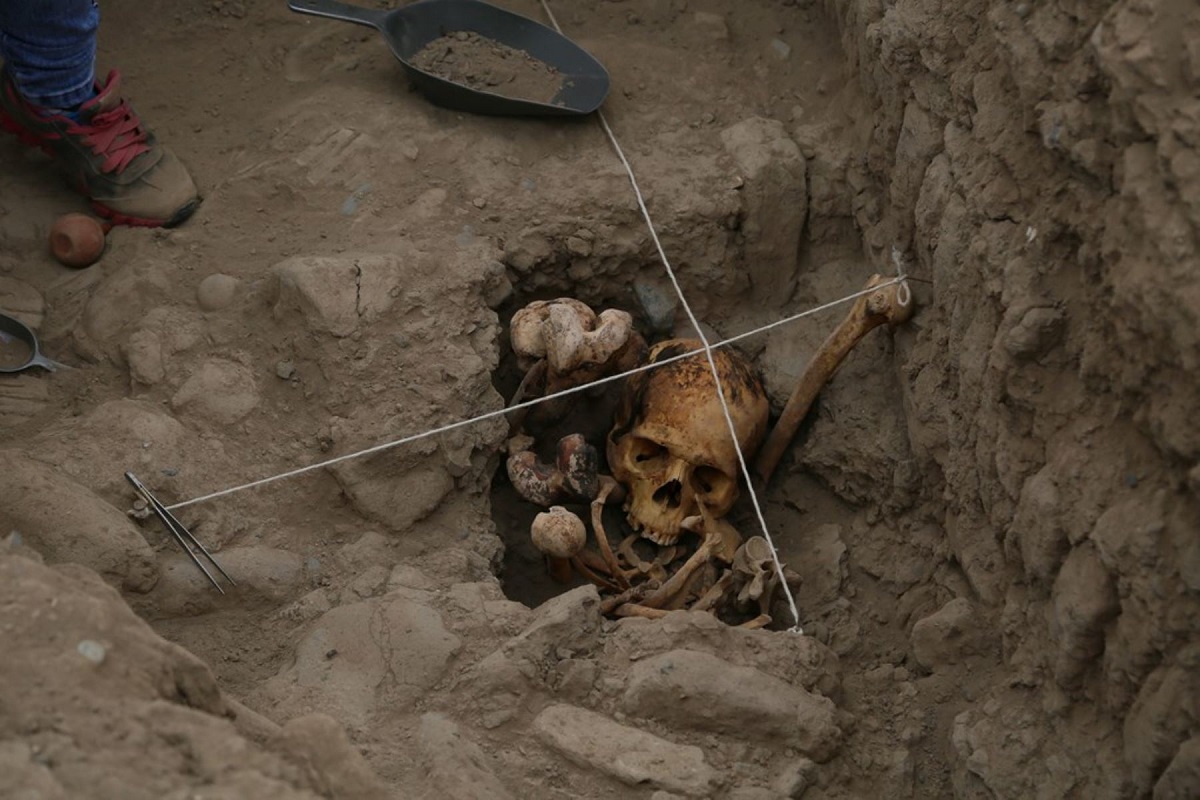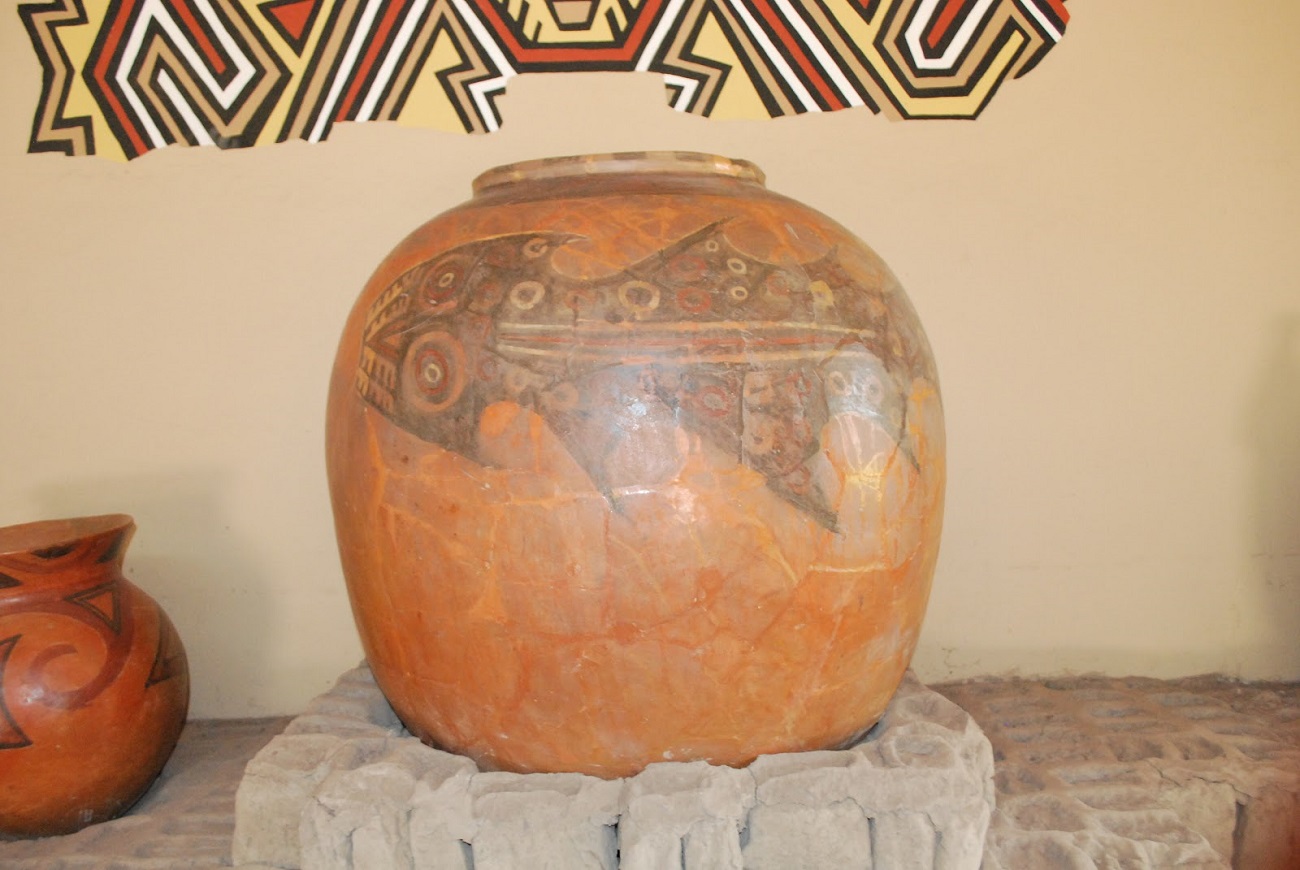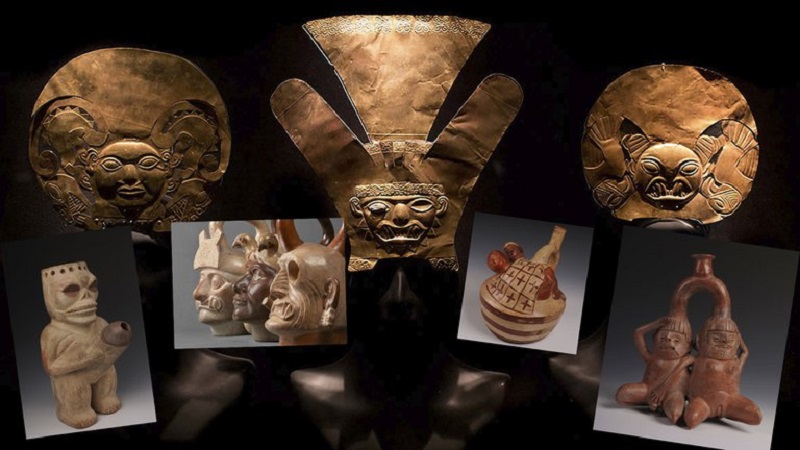Next in this interesting article we will be talking about everything that is La Culture Lima and we will delve into its origins from pre-Hispanic times to the present, hoping that it will be to your liking. Do not miss it!

Geographical location of the Lima culture
To talk about the Lima culture we must know where it was located, it developed primarily in the valleys of the Chillón, Rímac and Lurín rivers, located on the central coast of Peru. These three valleys (including the dry valley of Ancón) have common characteristics that give them geographical unity.
Peculiarity of the Lima culture
The distinctive feature of the Lima culture is its iconography, which is simple: most of its designs are based on the image of a pair of snakes with triangular heads, a smiling mystical being and an Octopus sp.
This iconography must have been created by weavers and then copied onto other materials and supports. Other particular characteristics of the culture of Lima are:
- Construction techniques, essentially two:
-The use of rammed earth, that is, walls made of large adobe or rammed earth of adobe.
-The use of small adobe in the shape of a parallelepiped, these arranged on the walls like books on a shelf. - The design of monumental architectural complexes, structured around squares and an adjacent residential area.
- Funerary customs of the Lima culture: they buried the bodies for a prolonged period, dorsal or ventral cubitus, a fact that abruptly broke the old tradition of the bodies in a flexed position.
Lima Culture: Main Settlements
According to the studies carried out, we can determine that the main cultural sites in Lima are:
- In the Chancay Valley: Cerro Trinidad.
- In the dry valley of Ancón: Playa Grande.
- In the Chillón Valley: Cerro Culebra, La Uva, Copacabana.
- In the Rímac Valley: Maranga, which is an immense architectural complex, the most important of the last phases of Lima's culture, currently in the districts of Cercado, San Miguel and Pueblo Libre, where the huaca de San Marcos stands out; the Cajamarquilla complex and the Nievería pyramid, both in the Lurigancho-Chosica district; Mangomarca, in the district of San Juan de Lurigancho; Huaca Pucllana, Pugliana or Juliana, in the coastal area of the district of Miraflores; the huaca Trujillo (Huachipa); Vista Alegre (near Puruchuco).
- In the Lurín Valley: the old temple of Pachacámac, that is, the oldest construction of this sanctuary.
Periods of the Lima culture based on its development
Researchers have made various attempts to progressively order the development of the Limia culture, mainly following the style of the ceramic pieces found.
Three great stages of Lima culture
As the Chavín culture disappeared, the communities on the central coast of present-day Peru developed in three stages until they were absorbed by the Huari culture. These steps differ primarily in the style of their respective ceramics and are named as follows:
- First step: Boza or Miramar baths (prelime culture, XNUMXrd century BC to XNUMXnd century AD)
Ceramic: white on red - Second stop: Playa Grande (Culture of Lima, XNUMXnd to XNUMXth centuries AD)
Tricolor ceramic: white, red and black.
Lock style - Third stop: Maranga – Cajamarquilla – Nievería (Lima culture, XNUMXth to XNUMXth centuries)
Ceramic tetracolor: white, red, black and grey.
The subdivision in phases by T. Patterson, for the Lima culture
These styles were subdivided in a classification made by the American archaeologist Thomas C. Patterson in 1964. This scholar, following the methodological contributions of John Rowe.
He defined 13 ceramic assemblage entities that share a significant number of characteristics and correspond to an equal number of phases:
The initial four phases are the antecedent of the culture of Lima, which is why it is also called pre Lima, and has been distinguished by the development of the style called white on red.
Whose ceramic samples were found in Miramar, near 'Ancón, which has been correlated with other specimens of a similar style found in Baños de Boza and Cerro Trinidad, in the Chancay valley.
The following nine phases or styles correspond correctly to the culture of Lima; the first seven correspond to the so-called nested style and the last two to Maranga.
pottery styles
Here is a brief explanation of the three main Pre Lima and Lima pottery styles: The White on Red [Pre Lima] style is known for its white painted decoration on the natural red background of the ship (another method was to first cover the surface of the ship with a white paint on which it was decorated with black lines. And Red).
The ceramic samples are crude in appearance, with simple geometric decoration. The most common shapes are nearly globular, short-necked pots, plates, bowls, small jugs, etc.
The nested style [Lima] is characterized by having as its main decorative motif a series of stylized figures in the form of intertwined fish or snakes, as geometric figures of lines and points. Use the colors white, red and black (tricolor) on a red background. Representative shapes are cups, jars, and glasses.
The Maranga [Lima] style is characterized by its decoration of frets, interlocking fish, intersecting lines, triangles, circles, and white dots. Use the colors red, white, black and gray (tetracolor) on a background of orange, thin, bright and shiny underwear.
The forms of ceramics are very varied, including the so-called lenticular form. Its final phase is known as the Nievería style.
Stages of Lima culture
First stop: Baños de Boza or Miramar, As already pointed out, this cultural stage is the immediate antecedent of the culture of Lima and follows the influence of Chavín and the beginnings of the Early Intermediate (XNUMXrd century BC to XNUMXnd century AD).
Although it is not credible that its ceramic style, called white on red, has given rise to the later porcelain styles of the Lima culture, since these seem to have a foreign origin. Even, as we know at the time of the change, the White on Red style coexisted for a long time with that of the Lima culture.
The student of this culture, Max Uhle, was the one who found white-on-red ceramic ruins in Cerro Trinidad, near the town of Chancay, in the early years of the XNUMXth century. He also found evidence of another pottery style, later to be called interlocking, which he mistakenly considered to be the oldest.
In the 20s, Alfred Kroeber continued his research at Cerro Trinidad, and later William D. Strong and John M. Corbett discovered remains of white-on-red pottery at Pachacámac, further south in the Lurín Valley. .
Gordon Willey was appointed to fully ensure the temporal sequence of the ceramic styles found at Cerro Trinidad, placing the White on Red style as the oldest in this part of the central coast. Willey also excavated at Baños de Boza.
At the same site in the Chancay Valley, which turned out to be an isolated site with an almost unique possession of the white on red style, thus becoming known as the 'Baños de Boza style'. Willey published the results of his studies in 1945.
Other explorations carried out in Miramar (near Ancón) have brought to light several specimens of ceramics with another form of the White on Red style, called “Miramar style”.
In 1964, the North American archaeologist Thomas Patterson, in his well-known sequence of phases of ceramic development, placed the White on Red or Miramar style in four phases, ahead of those of the Lima culture.
The White on Red style, in its Baños de Boza and Miramar modalities, prevailed in the pottery of the potters of all the neighboring communities of the central coast of Lima (Chancay, Ancón [dry valley], Chillón, Rímac and Lurín valleys). , after the cessation of the influence of Chavín-style pottery.
Excavations have brought to light the remains of almost globular pots, with short necks, with dilated and almost convex openings. Plates, glasses, small jars, etc. were also found.
At this point small fishing villages (Ancón) and farmers are known. The latter occupied stepped slopes of hills at the edge of the valley. Lateral streams were particularly important as they collected water during the rainy season.
A system of reservoirs in Huachipa allowed water to be stored. Vast cemeteries have been discovered in the Tablada de Lurín, ranging from 20 to 50 hectares, which housed thousands of burials from that time.
The presence of weapons, batons and enamels as funerary offerings and the evidence of shelters protected by walls in the upper parts of the hills indicate that relations with neighboring ethnic groups were not entirely peaceful.
Second stage: Playa Grande, In this period, its ceramic style corresponds to the first phase of the Lima culture (XNUMXnd to XNUMXth centuries AD).
What gives it its name is the colony of Playa Grande located in the current baths of Santa Rosa, district of Santa Rosa, metropolis of Lima, 3 km south of Ancón, found by Louis Stumer in 1952.
However, the style had already been previously identified by Max Uhle at Cerro Trinidad (Chancay), and studied by Kroeber (1926), Strong and Corbett (1943) and Willey (1943), under the name of nested or nested fish.
Because its main feature is a stylized design of intertwined fish (or snakes) that decorate the ceramic walls, combining the colors black, white and red (tricolor). Apparently, its origin is in the influence of the Recuay culture, located further north, in Áncash.
Its stratigraphic position as after Baños de Boza and before Maranga and Tiahuanaco-Huari was verified by detailed investigations carried out by Ernesto Tabío in 1957. Later, Patterson included it in his sequence of ceramic development that he includes under the name of «Lima» ( 1964).
Manifesting technological advancement, the potters who served in the ceremonial centers of this era made fine and pleasingly shaped ceramics, although large vessels of rough and crude appearance were also found.
The range of this style is located between the Chancay Valley to the north and the Lurín Valley to the south. To the east, it may have reached the Cisandean segment. All this suggests that the great lords of the central coast had expanded their domains.
The buildings made during the Baños de Boza-Miramar phase were developed, becoming large pyramids with stepped platforms. These buildings, which had the double function of being palace-temples, had enormous patios for ritual concentrations and commercial activities.
Urban complexes have also been built in various places in the valleys. Sanctuaries and noble dwellings were surrounded by vast plantations and corrals with abundant cattle.
The quadrangular base of the monumental architecture was made with stone walls. Then came the multi-story platforms, built with adobe bricks of different shapes and sizes. The interior walls were covered with mud.
Their walls were decorated in shades of red and white, which from a distance made them look like splendid buildings. Some main walls have been decorated in the interlaced style, in a multicolored way, as was discovered in Cerro Culebras (Chillon Valley).
To make these huge pyramids, with thousands of stones and millions of bricks, the participation of architects, masons, assistants, porters, painters, decorators, carpenters, technicians and a large amount of labor, a lot of work must have been necessary. Therefore, it follows that the population of the valleys must have been very large.
An important characteristic of this stage was the changes in funerary behaviour: the traditional flexed position of the body with the limbs strongly contracted, sitting or on one side, is replaced by the ritual of Lima, with the body in a lying position. Few of the dates obtained from carbon 14 would place this fact between the fourth and fifth centuries AD.
In Playa Grande, 12 graves with 30 people have been located; the most notable brought offerings of quartz, jadeite, turquoise, lapis lazuli, Spondylus, and obsidian. In one of the tombs, two trophy human heads are placed as an offering, as well as birds with beautiful plumage.
Of all the establishments of this time, Playa Grande was perhaps the most important, being at that time on a higher level than the old Pachacámac sanctuary and other settlements of the Lima culture.
The location of Playa Grande, facing the sea and a group of islands, shows its religious importance, as well as the richness of its ceramics and found instruments (for example, the Playa Grande sand spear).
Unfortunately, much of the information hidden in Playa Grande was destroyed with the construction of the spa; Currently, due to lack of resources and the interest of the authorities, the underlying remains may be lost in more than 100 hectares of the spa's undeveloped area; Domain in which several real estate agencies have placed their interest with the agreement of the state entity.
Other classic examples of the Playa Grande style have been found in the Chillón Valley, especially in Cerro Culebra and Copacabana, two towns with monumental architecture. Likewise, in the neighboring basins of Rímac (Huaca Trujillo, near Cajamarquilla, in Huachipa) and Lurín (Pachacámac and Tablada de Lurín) very comparable vessels and textiles have also been found, associated with Adobe architecture.
Third stage: Maranga – Cajamarquilla – Nievería: The last cycle of the history of the Lima culture (XNUMXth to XNUMXth centuries AD) was rescued by archaeologists mainly from discoveries in the Rímac and Lurín valleys.
Of crucial importance were the works of Cajamarquilla and Nievería (both on the right bank of the Rímac), as well as in the monumental complex of the pyramids of Maranga (left bank of the same river), today part of the university city of the Universidad of San Marco.
Max Uhle was the beginning of the investigation of the ceramic style of Nievería, with its fine finish and elegant decoration, which he related to other samples he found in Cerro Trinidad and which he called “Proto Lima”, because he believed that they were of Nasca origin. Raoul Dancourt, in 1922, preferred to call the pottery Nievería de Cajamarquilla.
Later, in 1949, the Ecuadorian culture scholar Jacinto Jijón y Caamaño used the term "Maranga" for the so-called "Proto Lima" period, the name of the architectural complex where he later studied. It was Stumer who suggested the names "Playa Grande" for the initial phases (then called interlacing) and "Maranga" for the last one.
And in 1964, T. Patterson unified these names under the word "Lima", divided into 9 phases, placing the Nievería style at the beginning of the Middle Horizon (660 AD). Nievería is currently defined as a local and contemporary diversity of the last phase of the Lima or Maranga style.
The so-called Maranga fashion could be a derivation of Playa Grande; the truth is that technically it surpasses it. Potters of this period made ceramics of various shapes, decorated with fretwork, interlocking fish, intersecting lines, triangles, circles, and white dots.
As for the coloration, it was tetracolor: in addition to the colors already used in the last phases of Playa Grande (red, white and black), a new color was added, gray. This style of pottery lasted until the domination of the Huaris, undoubtedly because it was superior to that of the conquerors, although it inevitably suffered from foreign influence.
It was in the final period of this stage, after an El Niño phenomenon that occurred between the XNUMXth and XNUMXth centuries AD during the resumption of intense agricultural activity in the Huachipa ravine. Settlements moved from easily defensible locations (hills or hills) to areas adjacent to cultivated fields.
All this led to the emergence of enormous pyramidal structures and their surrounding buildings and enclosures, the site of Cajamarquilla being the most spectacular in terms of size and extension. The other notable complex is that of Maranga.
Said pyramids (which would be palace-sanctuaries) in their structure followed the guidelines of other events of the previous stage, but they were complemented with some details. They are monumental architectural works, full of platforms and palaces, all painted yellow and white (the red from the previous step has been discarded).
In a good extension of these sanctuaries giant murals have been painted, mainly with figures of fish. These polychrome walls could be seen from afar.
In addition to the Maranga and Cajamarquilla-Nivería complexes mentioned above, there is other evidence of buildings belonging to this stage:
- In the lower valley of the Rímac (current province of Lima): Armatambo, at the foot of Morro Solar (Chorrillos); and Mangomarca (San Juan de Lurigancho), both currently affected by urban sprawl. Other relatively contemporary architectural evidence is the Huaca Pucllana (Miraflores) and the Huaca Granados (La Molina).
- In the Chillón Valley, the structures of Carabayllo and the huaca of Cerro Culebras stand out.
- In the dry valley of Ancón: the town of Playa Grande.
- In the Chancay Valley: the temple-palace of Cerro Trinidad, where a polychrome mural was found, with a design of intertwined fish.
- In the Lurín Valley: the old adobe temple of Pachacámac.
The ability to mobilize entire communities for public works and a certain standardization in the style of ceremonial pottery are indicative of the existence of a central political power.
Artistic manifestation
Architecture: the monumental complexes are typical of the Lima culture: tall pyramids with adjacent plazas and habitable spaces, accessible at their tops by paths lined with walls and ramps.
The colossal architecture of Lima has two recurring techniques:
- The use of rammed earth, that is, walls of large adobe or rammed earth.
- The use of small blocks of adobe in the shape of a parallelepiped, which replaced the plane-convex (paniform) adobe made by hand. Most often, these adobitos are placed vertically inside the wall, like books on a shelf. This technique did not survive after the end of the Lima culture.
A representative example of this architecture is the immense architectural complex of Maranga, today located in the urban area of Lima, between the districts of Cercado, Pueblo Libre and San Miguel. They are pyramidal monuments, with ramps and steps, enclosures and warehouses.
One of the most outstanding buildings of this complex is the Huaca de San Marcos, located on Avenida Venezuela, on the campus of the University of San Marcos. Huaca Pucllana, in the district of Miraflores, is another building characterized by the use of small blocks. It is a pyramidal shape that has a series of structures formed by straight walls that form enclosures and patios, also built in adobitos. Ceramics: The development of Lima ceramics is divided into two main stages:
The intertwined style or called Playa Grande, which is characterized by having as its main decorative motif a series of images in the form of intertwined fish or snakes, such as geometric figures of lines and points. Hence the name interlace which is translated from English means "intertwined" or "intertwined".
It combines the colors black, white and red (tricolor) on a red background. The pottery is fine and pleasingly shaped, though of course large, rough looking jars have also been found. The thin vessels found are spherical jars, cylindrical jars, goblet jars, bell-shaped jars, smooth-lined plates and bowls, mammal- or turtle-shaped jars.
The Maranga style, which presents a more frequent use of modeling. Its last phase is traditionally known as the Nievería style, already under the influence of Moche and Huari. The use of very fine clay stands out, as well as excellent firing conditions and surface finish. In its decoration, it is characterized by the presentation of frets, interlaced fish, intersecting lines, triangles, circles and white dots.
Use the colors red, white, black and gray (tetracolor) on a background of orange, thin, bright and shiny underwear. The forms of ceramics are very varied: there are lenticular vessels that, with a narrowing in its central part, appear two deep plates joined by their bases.
They have a bridge handle, sometimes joining two long, conical necks or a neck with the modeling of an anthropomorphic or zoomorphic figure or statuette (sculptural ceramic), or simply between the neck of the spout and the body of the vessel, which in these cases it is spherical in shape. There were also clay plates, pots and pitchers with a fine finish, the vast majority.
As we have already pointed out, in 1964 Patterson subdivided this ceramic development of the Lima culture into nine styles, the first seven corresponding to the nested style and the last two to the Maranga style:
- The Lima 1 phase was characterized by the production of pitchers and large plates, with black and white or burnished decoration.
- In the Lima 2 phase, there are straight-necked jars and plates, and a white or red slip is applied to the first surface.
- The Lima 3 phase, in which straight glasses, large jugs, plates, etc.
- Lima 4 phase, in which a new type of pot with a flat edge appears, with painted decoration.
- Phase 5 of Lima where plates with curved sides, flat edged pots and mammal pitchers stand out, and the recurring motif is the nested serpent.
- The Lima 6 phase, in which the great pitchers predominate.
- The Lima 7 phase has pots with curved necks and pots with flared necks, among others, decorated with painted interlocking triangles and serpents.
- The Lima 8 phase, in which the previous forms are repeated, with a decoration of triangles, wide bands of colors and fine lines painted white.
- The Lima 9 phase, which takes the previous forms and the snake is intertwined in the decoration.
Textile art
Textiles were another important activity for that culture. They made extensive use of cotton fibers and camelid wool. The dominant decorations are the same as those on ceramics: figures of fish, snakes and various lines, intertwined.
During the Maranga period, a greater number of colors were used compared to pottery. Blue, gray, green, brown, and various shades of red appear. Upholstery (for the first time on the central coast), brocades, and painted fabrics also emerged around this time.
feather art
The art of the pen was one of the characteristic artistic activities of the archives. It consisted of fixing painted or selected feathers in different colors (red, green, black, blue and yellow), sewing them in a design scheme that gives the coat an extraordinary beauty.
The feathers come mainly from sea birds, parrots, macaws and other species from the inter-Andean valleys, originating from inter-regional trade. These feathered fabrics were for the exclusive use of the lords in charge of the cult or the government.
Basketry
Basketry is another artistic activity with a remarkably developed technique. The archaeologist Ernesto Tabío, who carried out the excavations in Playa Grande, pointed out that "it was a remarkably basket-making town" (1955).
Indeed, he found an extraordinary number of baskets, with a great variety in their construction techniques, their decorative patterns, their dimensions and their shapes.
Economy
Like all the cultures of the coastal zone, the foundation of its economy was basically fishing and agriculture.
Fishing
Something very common in the civilizations of the coast, fishing was a fundamental activity. The most curious thing is that in addition to the manual fishing species (pejerrey, corvina, cojinova, liza, etc.)
Remains of fish that are only found in schools of 100 or 200 m depth have also been discovered, such as, for example, machete, sardine, anchovy and bonito. It is unknown how they were captured.
They were magnificent divers, there is no doubt about that. They removed seashells up to 8 m deep, which served as a decorative object. In all the palaces they were found in large numbers.
Agriculture
Agriculture has become an intense activity. They obtained agricultural land through a network of canals or aqueducts, some of which are still in use today. Their main crops were: corn, broad beans, beans, squash, pumpkin, sweet potato, peanut, custard apple, lucuma, pacae, etc.
Such would be the fertility of the coastal valleys and the number of farms or cultivated areas, it is estimated that the Rímac valley alone would house a population of 200.000 people. Spanish chroniclers have attested that this valley was indeed the richest in ruins and remains of ancient buildings, especially in the lower region, near the sea.
Francisco Pizarro's choice to found the capital of his government there, now the capital of the Peruvian Republic, was based on a pre-existing, prosperous and densely populated colony. For this reason, we can say that the city of Lima was not actually born in 1535, the year of its Spanish foundation, but that its antecedents go back several centuries. To ensure the permanent irrigation of their fields and the supply of water to the populations, the limes built two monumental hydraulic structures in the Rímac Valley that are still in use today:
- The Surco River, which is an irrigation channel that carries the waters of the Rímac River from Ate to Chorrillos, passing through Santiago de Surco, Miraflores and Barranco.
- The Huatica Canal, which carries water from La Victoria to Maranga.
The infrastructure was built in the last period, the so-called Maranga, between 500 and 700 AD It is possible that the droughts of the XNUMXth century and the increase in rainfall caused by an El Niño phenomenon during the XNUMXth century were the decisive stimuli for this work.
Stores
At the height of Lima culture, the entire area it occupied had undoubtedly become a large commercial center. Its valleys connected it with strategic places in the mountains, with whose inhabitants their products were exchanged. In the archaeological sites there are still elements from neighboring regions and cultures, which naturally exerted influences on the artistic manifestations of the limes, as Luis Lumbreras emphasizes:
“The culture of Lima is not an impersonal culture; To explain it, it is necessary to resort to their relations with many other cultures of the coast and the mountains, being their character of strong receptivity. «.
burials
Two forms of burial were found:
- Common: The carcass was covered with one or two layers, accompanied by some household utensils, placed in a horizontal position and buried 1 m or 1,5 m deep.
- Particularity: the corpse was placed on a stretcher (a kind of bunk or portable bed) made of sticks and reeds. The position of the deceased varies according to the climate: for the stage before Lima, that is to say the so-called Baños de Boza ("White on Red"). The position is lateral; for the next stage or Playa Grande ("nesting"), the body is placed on the ventral cubitus (face down) with the stretcher on the back; and for the final stage or Maranga, it is placed on its dorsal ulna (face up). Wrapped in various decorated robes, with various domestic and war utensils, and accompanied by another deceased, one possibly sacrificed in his honor.
end of a culture
All excavated constructions in Lima indicate that they were abandoned in the XNUMXth century AD It has been hypothesized that the causes were natural cataclysms or destructive alien invasions, such as that of the Huaris. However, the remains indicate that it was an organized closure of public spaces in full compliance with precise regulations. Courtyards and other constructions on top of the pyramids were buried with intentional fillings.
The accesses were closed with adobe walls, clay blocks or stone. We do not know if all the cases of closure and abandonment occurred at the same time and for the same reasons. Ultimately, it is possible that it is a ritual linked to the death of the last residents of each palace in the Maranga phase.
In any case, burials and other evidence of human activity show that Lima's public architecture was abandoned when vessels and textiles adorned with Tiwanacu and Nasca designs (Viñaque, Pachacámac and Atarco styles) came to light. widespread on the central coast. On occasion, local potters also adopted these expressions (Nevería style).
This scenario of the collapse of central power contrasts with the diffusion of the local style, Nievería, in Lambayeque, with other southern styles. It is probable that various representatives of the Lima elites joined other Huari groups and participated in the conquest of the north.
At that time, the Pachacámac Sanctuary was gaining importance as a center of attraction for thousands of pilgrims, hence the cult of the god of the same name spread throughout the Andean world. Perhaps it is in this center where the hypothetical alliance between the Lima and the Huari was sealed.
A little more about Lima Culture
The Lima culture developed in the valleys formed by the Chillón, Chancay, Rímac and Lurín rivers. According to archaeological investigations, in particular the study of discovered ceramics, two cultural areas have been identified on the central coast between 200 BC. C. and 100 AD, one to the north of the Chillón River.
Here the ethnic groups that settled there developed what archaeologists called the Baños de Boza or Miramar style, which has characteristics similar to the Salinar culture; and one to the south of the Chillón river, which rather presents the characteristics of the Paracas necropolis. It wasn't until 100 AD and until around 700 AD, that there is a particular style called Lima.
Cultural influence of Lima culture
From the XNUMXth and XNUMXth centuries AD, the style of the Lima culture acquired prestige and was imitated throughout the central coast. But it is also evident that many cultural models of this time are influenced by other coastal traditions. This shows that cultural contacts with other regions have increased considerably.
Environment
The area of the central coast, where the men of the Lima culture settled, has a mild climate, not as hot as in the south or north, although a little more humid and subject to changes in temperature and the formation of microclimates. The presence of complementary ecosystems should be emphasized; the valleys, the sea, the swamps, as well as the coastal hills were used by the inhabitants of this region for their livelihood.
Lima culture organization
The cemeteries and the large number of graves found in the area of influence of this culture indicate that they were territorial communities, organized in nuclei of extended families. On the other hand, the presence of weapons as funerary offerings and the existence of shelters protected by walls in the upper parts of the hills suggests that its inhabitants have faced serious conflicts.
Later, during the peak period, the main ceremonial centers were built and the existence of a centralized political power capable of mobilizing hundreds of people for public works can be seen. Although it is difficult to pinpoint the end of this culture, it is suggested that it was due to the expansion of the Huari, who gradually occupied the cultural sites of Lima.
Ceramics
Ceramics have been a key element in the reconstruction of the evolution of the Lima culture, as well as the network of contacts that it has developed with other regions. Initially, the influence of Salinar and the Paracas necropolis is clear. It is the time of the boom, a particular style appears characterized by geometric figures that give the appearance of crested and intertwined serpent bodies with triangular heads, although some scholars consider that the origin of this representation was in the northern mountains, with the Recuay culture. .
Architecture
Researchers recognize two phases in the development of Lima culture. The first stage of the culture is called Playa Grande or Enclavamiento, in which the temples of Cerro Culebra stand out, on the banks of the Chillón River and Cerro Trinidad in Chancay, with impressive murals.
The second stage of the culture is called Maranga; It was then that the first monumental public buildings were built. The high-rise pyramids had enclosures and plazas in the highest areas, connected by paths protected by ramps and walls, which had storage areas and others dedicated to production.
These buildings were built with small flattened adobes, placed as a shelf; Another material, pressed clay, was also used. Huaca Maranga stands out as the most important center built in the lower part of the Rímac River.
Other important centers were the Pucllana huaca and the Pachacamac adobe temple, but the largest was Cajamarquilla, since it occupied some 167 hectares where enclosures were built that had various uses, such as houses, warehouses and places of worship.
Citadel of Cajamarquilla
One of the largest pre-Hispanic population sites that have been maintained, with more than 6 thousand square meters, is Cajamarquilla, an archaeological site located west of Lima (Ate-Vitarte). It was built around 400 AD
It is made up of eleven main pyramids, surrounded by many single-storey, rectangular-shaped houses. This spatial arrangement contributed to what is called the Labyrinth, the construction of the pyramids was done through huge vertical trapezoidal mud panels.
Each of these gigantic fabrics is made up of several layers of clay superimposed on each other. The first reconstructions that were made of this architectural complex were not carried out according to the original plan.
Chincha culture close to Lima
This ethnic group flourished between 900 and 1450 AD, it emerged in the valleys of Cañete, Chincha, Pisco, Ica and Nazca. Perhaps they built a warlike regional state inferior to the Chimú, which penetrated the Andean region, which opposed the tenacious resistance to the advance of the Inca Empire.
Political organization of the Chincha culture
The geographical situation in which this culture settled gave it political importance, since it knew how to unite the chiefdoms and lordships of the central and southern coast, which thus appear as a nucleus compared to the Chimús of the north and the Incas of Cuzco to which the domain they exercised over the sea is added.
Likewise, the inhabitants of this culture have captured the cultural elements that, although they showed their own imprint, could not however be exempt from the influence of their ancestors such as the Paracas, the Nazcas and even the Waris themselves.
With all these elements, the inhabitants of the Chincha culture have exercised their political preponderance in these places for two centuries.
Architecture
They were not manufacturers of great cities and their architecture is manifested in the temples, palaces and fortresses that they built with adobe and bricks. They applied the stucco technique, decorating the walls with fish heads, gannets and other sea birds. Around these buildings, they built houses of mats and reeds where the majority of the population lived.
Ceramics
The huacos were made of red clay, with decorations on their surface with geometric patterns and humanoid figures based on stylized animal, bird and fish forms. The colors used were black, white, grey, cream and red.
This pottery shows some Wari influence but at the same time expresses its uniqueness with the globular indentations of the body and the long neck joined by integrated handles.
trade and navigation
Driven by a growing economy, this culture crossed the sea on large rafts, managing to reach the current port of Valdivia (Chile).
Thus, they practiced a form of trade for which they had a system of weights, measures and scales, in such a way that they exchanged their goldsmith products, textiles, carpentry and even dried fish, for others that served them as food or for their development. artisan.
His religious divinity was Chinchaycámac and his capital the city of Chincha, being in turn the last leader of this Guavia Rucana culture, during the Inca expansion, they were invaded and joined Tahuantinsuyo.
Merchants of Chincha
The Chinchas were extraordinary merchants along the Peruvian coast. The chronicles tell that in Chincha there was a large number of merchants who traded along the coast using rafts.
Historian María Rostworowski says that these traders reached the Manta region of Ecuador, where they obtained the most valuable spondylus or mullu. There was also a land trade with llamas and porters who arrived in Cusco and Callao where the mullu was exchanged for tin-copper.
It is believed that when the Incas subdued the Chincha, their commercial power diminished, while retaining their importance. So much so that during the capture of Atahualpa in Cajamarca, the only person transported in the litter, apart from the Inca, would have been the lord of Chincha whom the Inca considered his friend.
Tomb
Collective tombs are known, such as the one unearthed in Uchuglla, Ica, formed by rectangular underground graves with adobe walls and thatched roofs supported by beams; made of logs.
Inside, several packages were lined up, along with a large number of offerings that include objects in gold, silver, ceramics, carved wood, etc. These tombs correspond to figures of high social status.
The tomb discovered at Uchuglla had a spit or frame of huarango trunks with images of animals carved in relief as a roof.
If you found this article interesting, we invite you to enjoy these others:


